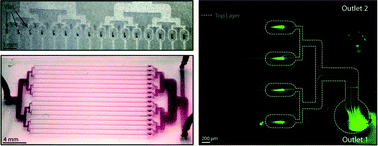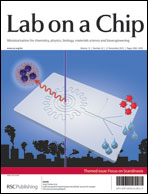Passive particle focusing based on inertial microfluidics was recently introduced as a high-throughput alternative to active focusing methods that require an external force-field to manipulate particles. In this study, we introduce inertial microfluidics in flows through straight, multiple parallel channels. The scalable, single inlet and two outlet, parallel channel system is enabled by a novel, high-density 3D PDMS microchannel manufacturing technology, mediated via a targeted inhibition of PDMS polymerization. Using single channels, we first demonstrate how randomly distributed particles can be focused into the centre position of the channel in flows through low aspect ratio channels and can be effectively fractionated. As a proof of principle, continuous focusing and filtration of 10 μm particles from a suspension mixture using 4- and 16-parallel-channel devices with a single inlet and two outlets are demonstrated. A filtration efficiency of 95–97% was achieved at throughputs several orders of magnitude higher than previously shown for flows through straight channels. The scalable and low-footprint focusing device requiring neither external force fields nor mechanical parts to operate is readily applicable for high-throughput focusing and filtration applications as a stand-alone device or integrated with lab-on-a-chip systems.

You have access to this article
 Please wait while we load your content...
Something went wrong. Try again?
Please wait while we load your content...
Something went wrong. Try again?


 Please wait while we load your content...
Please wait while we load your content...